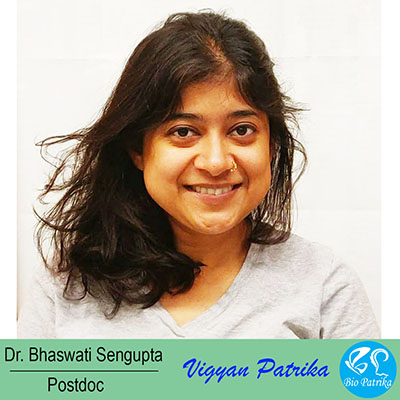Dr. Bhaswati Sengupta’s interview with Bio Patrika hosting “Vigyan Patrika“, a series of author interviews. Dr. Sengupta is currently working on Nucleosome dynamics and chromatin remodelling using smFRET as a postdoc in the Department of Chemistry at Pennsylvania State University, USA. She did her PhD from the lab of Prof. Pratik Sen, Department of Chemistry, Indian Institute of Technology Kanpur, India. She published last part of her PhD work titled “Fluorescence correlation spectroscopy as a tool to investigate the directionality of proteolysis” as the first author in International Journal of Biological Macromolecules (2020).
How would you explain your paper’s key results to the non-scientific community?
Proteins are a long chain of amino acid molecules connected by a peptide bond. Proteolysis is a significant part of the digestion system where the protein gets cleaved into smaller peptides. In this paper, we have used human serum albumin (HSA) as a model protein and papain, chymotrypsin, and trypsin as enzymes to digest HSA. Being a long-chain protein, HSA can be cleaved from either side. In this work, we have used fluorescence correlation spectroscopy (FCS) to understand exactly from which side these enzymes cleave HSA. FCS enables us to measure the change in the size of the fluorescently labelled fragments. As the digestion proceeds, the size becomes smaller, which we measure by FCS. By preferentially labelling to two sides of the protein chain with fluorescent dyes, we can see from which side the digestion process starts. The principle of the measurement is shown in Scheme 1.

Scheme 1: Monitoring protein digestion by single molecule technique.
HSA is a large protein having three domains. For HSA, we found out that digestion starts from the domain I for all three enzymes under consideration. Fluorophore 1 (TMR) slows the faster decrease of size as compared to fluorophore 2 (NPCE) labelled one, which indicates that the fragment size decreases faster for the domain I indicating that digestion starts from the domain I. We have also performed reverse-phase high-performance liquid chromatography (RP-HPLC) to cross-check the findings, supporting our results.
What are the possible consequences of these findings for your research area?
Several techniques enable the measurement of digested fragments after proteolysis like mass spectrometry, HPLC, etc. The uniqueness of the proposed approach is its ability to tell directionality using a minimum amount of protein. FCS is sensitive and can be successfully used for picomolar to nanomolar sample concentrations. This is a new application of the single-molecule research that can be used to understand proteins’ digestion profile.
“[…] I see you are now able to think of novel ideas and design the experiments; your training has been completed”
What was the exciting moment (eureka moment) during your research?
There is more than one Eureka moment associated with this specific work. This was the last project I worked on during my PhD. When I conceived the idea and shared with my boss, he said, “I see you are now able to think of novel ideas and design the experiments; your training has been completed”. That was some words of motivation before I could start the next venture. When I started working, I was unsure if I would see any difference in the digestion profile monitored by two different fluorophores labelled at two other locations. If there was no difference, there was no specific conclusion, and it wouldn’t have been as fascinating as the current finding. So when I observed a difference in the digestion profile, I was pretty excited, which was definitely the second eureka moment. The third eureka moment would be when the reverse phase HPLC supported the single-molecule measurements. That was the moment when we found proof that whatever we see in single-molecule measurement is valid.
What do you hope to do next?
Regarding the piece of work, I talked about, I am not following up on that anymore. We had several ideas of trying the technique on different proteins and used different enzymes and different environments. Also, to use drugs to see if they affect the digestion profile etc. But unfortunately, I had to leave to join a postdoc and couldn’t continue with it. If someday I get a chance, I would like to work on the extended ideas.
Where do you seek scientific inspiration?
The best (or the worst) thing being a researcher is that I don’t know what waits ahead, and from my early childhood, I have felt tremendous attraction towards what is unknown. It feels exciting to delve into the strange world, which is why I keep loving science. Besides, I am blessed to have supervisors (PhD and postdoc) who motivate and have always believed in my ability and dedication. The excitement of discovering something new is often inexplicable. All these factors keep me going, and I wish to be roaming around the field of science forever.
How do you intend to help Indian science improve?
Honestly, “improving Indian science” is a huge goal, and I don’t think I have reached the stage to think about it. Right now, I am doing postdoctoral research and wish to set up my lab in India someday. Provided I can do that; my next goal would be to design experiments with minimum budget and resources possible given the poor condition of the academic budget in India. The next target would be to equip the lab with efficient and budget-friendly instruments. Once all these are in place, one can use single-molecule experiments for several biological and chemical applications using a minimum sample amount. This will cut down the cost of buying or producing expensive samples again and again.
Reference
Sengupta B, Das N, Singh V, Thakur AK, Sen P. Fluorescence correlation spectroscopy as a tool to investigate the directionality of proteolysis. Int. J. Biol. Macromol. 2020; 164: 2524-2534.
Email: bhaswati1487@gmail.com

Pingback: Bio Patrika Volume 1, Issue 1 – Bio Patrika